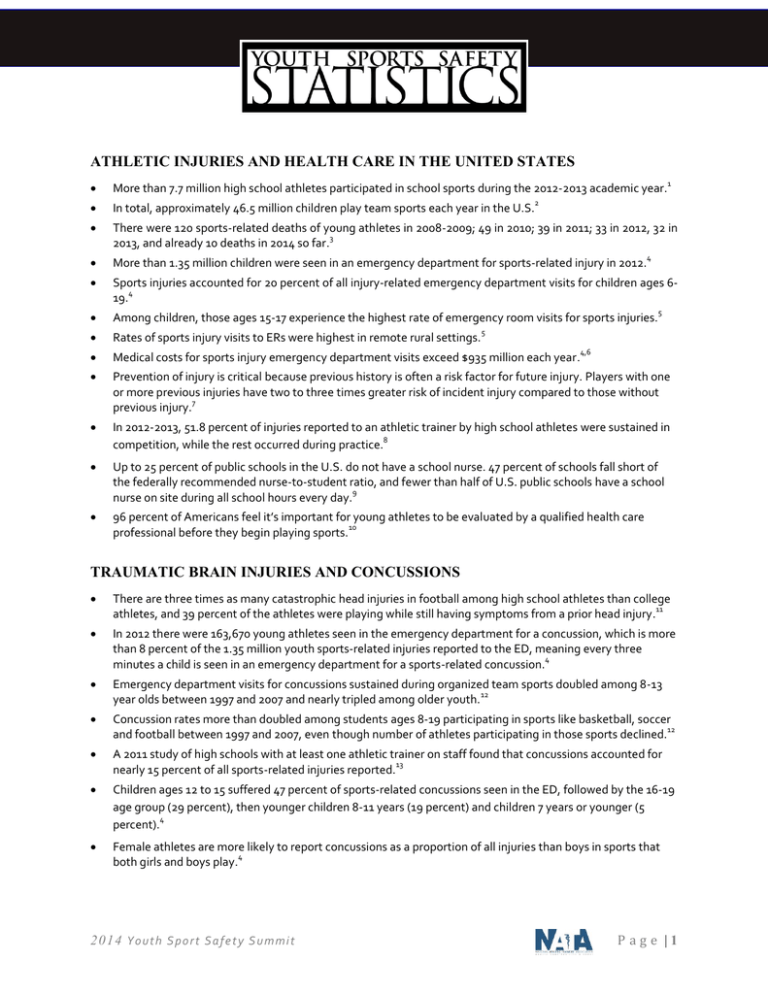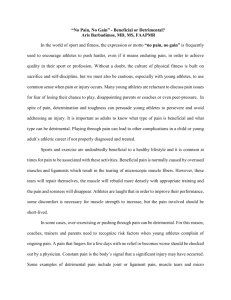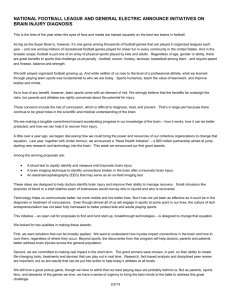ATHLETIC INJURIES AND HEALTH CARE IN THE UNITED STATES
advertisement

ATHLETIC INJURIES AND HEALTH CARE IN THE UNITED STATES More than 7.7 million high school athletes participated in school sports during the 2012-2013 academic year. In total, approximately 46.5 million children play team sports each year in the U.S. There were 120 sports-related deaths of young athletes in 2008-2009; 49 in 2010; 39 in 2011; 33 in 2012, 32 in 3 2013, and already 10 deaths in 2014 so far. More than 1.35 million children were seen in an emergency department for sports-related injury in 2012. Sports injuries accounted for 20 percent of all injury-related emergency department visits for children ages 64 19. Among children, those ages 15-17 experience the highest rate of emergency room visits for sports injuries. Rates of sports injury visits to ERs were highest in remote rural settings. Medical costs for sports injury emergency department visits exceed $935 million each year. Prevention of injury is critical because previous history is often a risk factor for future injury. Players with one or more previous injuries have two to three times greater risk of incident injury compared to those without 7 previous injury. In 2012-2013, 51.8 percent of injuries reported to an athletic trainer by high school athletes were sustained in 8 competition, while the rest occurred during practice. Up to 25 percent of public schools in the U.S. do not have a school nurse. 47 percent of schools fall short of the federally recommended nurse-to-student ratio, and fewer than half of U.S. public schools have a school 9 nurse on site during all school hours every day. 96 percent of Americans feel it’s important for young athletes to be evaluated by a qualified health care 10 professional before they begin playing sports. 1 2 4 5 5 4,6 TRAUMATIC BRAIN INJURIES AND CONCUSSIONS There are three times as many catastrophic head injuries in football among high school athletes than college 11 athletes, and 39 percent of the athletes were playing while still having symptoms from a prior head injury. In 2012 there were 163,670 young athletes seen in the emergency department for a concussion, which is more than 8 percent of the 1.35 million youth sports-related injuries reported to the ED, meaning every three 4 minutes a child is seen in an emergency department for a sports-related concussion. Emergency department visits for concussions sustained during organized team sports doubled among 8-13 12 year olds between 1997 and 2007 and nearly tripled among older youth. Concussion rates more than doubled among students ages 8-19 participating in sports like basketball, soccer 12 and football between 1997 and 2007, even though number of athletes participating in those sports declined. A 2011 study of high schools with at least one athletic trainer on staff found that concussions accounted for 13 nearly 15 percent of all sports-related injuries reported. Children ages 12 to 15 suffered 47 percent of sports-related concussions seen in the ED, followed by the 16-19 age group (29 percent), then younger children 8-11 years (19 percent) and children 7 years or younger (5 4 percent). Female athletes are more likely to report concussions as a proportion of all injuries than boys in sports that 4 both girls and boys play. 2014 Y ou t h S po r t Sa fe t y S u mmi t Page |1 Females ages 10-19 years sustained sports- and recreation-related TBIs most often while playing soccer or 14 basketball or while bicycling. Athletes ages 13 to 16 take a longer time to recover following a concussion – measured with memory tests, 15 reaction times and a symptom scale – than athletes ages 18 to 22. Additionally, serious and potentially fatal diffuse brain swelling is more common in children who have 16 suffered a TBI than in adults with TBIs. The percentage of children who required hospitalization for sports-related concussions is almost double the 4 percentage of non-concussion sports injuries requiring hospitalization. 15.8 percent of high school football players who sustain a concussion severe enough to cause loss of 17 consciousness return to play the same day. Young athletes who have been concussed are three times more likely to suffer another concussion in the 18 same season. SUDDEN CARDIAC ARREST Sudden cardiac arrest (SCA) is the leading cause of death in exercising young athletes. Often the underlying cause of sudden cardiac death is a structural cardiac abnormality, however as many as 80 percent of these patients are asymptomatic until sudden cardiac arrest occurs and some underlying causes 20 may not be detectable upon thorough screening in pre-participation physical exams. Just one in 10 U.S. student athletes who suffer sudden cardiac arrest survives. The greatest factor affecting survival after SCA is the time from arrest to defibrillation. Survival rates have been reported at 41-74 percent if bystander CPR is provided and defibrillation occurs 23 within three to five minutes of collapse. 19 21 22 HEAT ILLNESS 31 high school football players died of heat stroke complications between 1995 and 2009. The period of 2005 to 2009 had more heat stroke deaths than any other five year period in the 35 years 24 prior. The number of heat-related injuries from 1997 to 2006 increased 133 percent. Youth accounted for the largest 25 proportion of heat-related injuries at 47.6 percent. Young male athletes are at the highest risk of suffering exertional heat illness requiring treatment in U.S. 26 hospital emergency rooms due to the increased rate of occurrence in high school football players. The majority of time-loss heat illnesses occurred among high school football players (70.7 percent) at a rate 26 10 times higher than the average rate for eight other high school sports. 64.7 percent of football players sustaining a heat illness were either overweight or obese. Two-thirds of young athletes show up for practice at least significantly dehydrated. Although heat stroke is usually among the top three causes of death in athletes, it may rise to the primary 29 cause during the summer. Exertional heat stroke can be prevented and it has proven to be 100 percent survivable when immediately 30 recognized and aggressively cooled on site. 2014 Y ou t h S po r t Sa fe t y S u mmi t 24 27 28 Page |2 CERVICAL SPINE INJURY From 1977-2012, there have been a total of 266 high school football players with incomplete neurological 31 recovery from cervical cord injuries. It is estimated that 12,000 new cases of spinal cord injury occur each year in the United States. Approximately 32 80 percent of these injuries occur in males. Sport participation constitutes the fourth most common cause (approximately 8 percent) of all spinal 32 33 injuries, but it is the second most common cause after motor vehicle crashes for those under the age of 30. Football is associated with the highest number of cervical spine injuries of any sport in high school, while cheerleading is associated with the highest number of direct catastrophic head and neck injuries for high 34 school females. High school gymnastics and ice hockey have higher incidence rates of direct catastrophic head and neck 34 injuries than football when comparing participation numbers. ASTHMA About one in 12 people in the U.S. (about 25 million) have asthma, and the numbers are increasing every 35 year. Rates as high as 23 percent have been reported in school age children, and the incidence in athletes may also 36 be this high. It is estimated that 80 to 90 percent of all individuals who have allergic asthma will experience symptoms of exercise-induced asthma with vigorous exercise or activity. For teenagers and young adults this is often the 37 most common cause of asthma symptoms. Approximately 10 percent of otherwise healthy school children have been reported to have exercise-induced 38 asthma without other daily symptoms of asthma. 3,404 people died from asthma in the United States in 2010, a staggering number for a condition that can be 39 managed effectively. ANABOLIC-ANDROGENIC STEROIDS/DIETARY SUPPLEMENTS Nearly 6 percent of middle school and high school boys in urban areas admitted to using appearance and performance enhancing drugs without a physician’s prescription, and 4.6 percent of girls at this level also 40 admitting to using steroids. In addition, 35 percent of the students who responded said they used protein supplements, and 11 percent 40 claimed to use other muscle-enhancing supplements. Use of three or more muscle modifying behaviors such as intake of protein supplements, steroids, altered eating patterns, exercising, other muscle enhancing tactics, etc. was more than twice as high among boys 40 who participated in sports versus those who did not play sports. 85 percent of youth in high school have never had a parent, teacher or coach talk to them about the dangers 41 of appearance and performance enhancing drugs. In 2011 there were 1,499 energy drink-related emergency department visits by 12-17 year olds. The occurrence of energy drink-related emergency department visits among adolescents and young adults shows 42 that these vulnerable populations experience negative health events after consuming energy drinks. 2014 Y ou t h S po r t Sa fe t y S u mmi t Page |3 MENTAL HEALTH Approximately 13-20 percent of children living in the United States experience a mental disorder in a given 43 year, and surveillance during 2005-2011 has shown the prevalence of these conditions to be increasing. Suicide, which can result from the interaction of mental disorders and other factors, was the second leading 43 cause of death among children ages 12-17 years in 2010. While school is the most commonly mentioned source of stress for teens, more than half of teens report that 44 managing their time to balance all activities is a somewhat or very significant stressor. Teens ages 13-17 report that their stress level during the school year far exceeds what they believe to be 44 healthy and even exceeds adults’ average reported stress levels. 27 percent of teens report experiencing a level of stress that is an 8, 9 or 10 on a 10-point scale during the 44 school year. 31 percent of teens say that their stress level has increased in the past year, and 34 percent believe their stress 44 levels will increase in the coming year. 44 One-third of teens report feeling overwhelmed and depressed or sad as a result of stress. EXERTIONAL SICKLING Sickle cell trait was the primary cause of death for 15 out of the 2,387 athlete deaths recorded between 198045 2010. All but one of the deaths due to exertional sickling occurred during practice. Those who passed away were 45 predominantly African-American, male football athletes with an average age of 18.5 years. Young athletes with sickle cell trait may be at an increased risk of heat-related illnesses and their 46 complications. Predisposing factors to exertional sickling include heat, dehydration, race, altitude, asthma and high intensity 47 exercise with few rest intervals. 2014 Y ou t h S po r t Sa fe t y S u mmi t Page |4 REFERENCES 1 National Federation Of State High School Associations. 2012-2013 High School Athletics Participation Survey. http://www.nfhs.org/ 2 National Sporting Goods Association. 2011 vs 2001 Youth Sports Participation, NSGA. http://www.nsga.org/files/public/2011vs2001_Youth_Participation_website.pdf 3 National Athletic Trainers’ Association. (unpublished media review) 4 Ferguson RW. Safe Kids Worldwide Analysis of Consumer Product Safety Commission (CPSC) National Electronic Injury Surveillance System (NEISS) data, 2013. 5 Wier L, Miller A, Steiner C. Sports injuries in children requiring hospital emergency care, 2006. Rockville, MD: Agency for Healthcare Research and Quality; 2009. HCUP Statistical Brief #75. http://www.hcup-us.ahrq.gov/reports/statbriefs/sb75.pdf. 6 Centers for Disease Control and Prevention. Web-based Injury Statistics Query and Reporting System (WISQARS) Cost of Injury Reports. Available at: http://wisqars.cdc.gov:8080/costT/. 7 Kucera KL, Marshall SW, Kirkendall DT, Marchak PM, Garrett WE Jr. Injury history as a risk factor for incident injury in youth soccer. Br J Sports Med. 2005;39(7):462. 8 Comstock RD. HS RIO National Sample Results, 2012-2013. 9 National Association of School Nurses. 2008 Survey. www.nasn.org. 10 Kelton Research online survey representative of the U.S. population, + 3.1 percent margin of error. American College of Sports Medicine. http://www.acsm.org/about-acsm/media-room/acsm-in-the-news/2011/08/01/athletes-physicians-urge-adoption-of-new-medical-screeningtool. 11 Boden B, Tacchetti RL, Cantu RC, Knowles SB, Mueller FO. Catastrophic head injuries in high school and college football players. Am J Sports Med. 2007;35(7):1075-1081. 12 Bakhos L, Lockhart G, Myers R. Emergency department visits for concussion in young child athletes. Pediatrics. 2010;126(3):e550-e556. 13 Meehan WP, d’Hemecourt P, Collins C, Comstock RD. Assessment and management of sport-related concussions in United States high schools. Am J Sports Med. 2011;39(11):2304-2310. dol:10.1177/0363546511423503. 14 Gilchrist J, Thomas KE, Xu L, McGuire LC, Coronado VG. Nonfatal sports and recreation related traumatic brain injuries among children and adolescents treated in emergency departments in the United States, 2001-2009. MMWR Morb Mortal Wkly Rep. 2011;60(39):1337-1342. 15 Zuckerman SL, Lee YM, Odom MJ, Solomon GS, Forbes JA, and Sills AK. Recovery from sports-related concussion: Days to return to neurocognitive baseline in adolescents versus young adults. Surg Neurol Int. 2012; 3:130. 16 Meehan WP, Taylor AM, Proctor M. The pediatric athlete: younger athletes with sport-related concussion. Clin Sports Med. 2011; 30:133-144. 17 Yard E, Comstock R. Compliance with return to play guidelines following concussion in U.S. high school athletes, 2005-2008. Informa Healthcare. 2009;23(11):888-898. 18 Gessel LM, Fields SK, Collins CL, Dick RW, Comstock RD. Concussions among United States high school and collegiate athletes. J Athl Train. 2007; 42(4): 495-503. 19 Drezner JA. Preparing for sudden cardiac arrest: the essential role of automated external defibrillators in athletic medicine: a critical review. Br J Sports Med. 2009;43(9):702-707. 20 Basso C, Maron BJ, Corrado D, Thiene G. Clinical profile of congenital coronary artery anomalies with origin from the wrong aortic sinus leading to sudden death in young competitive athletes. J Am Coll Cardiol. 2000;35(6):1493–1501. 21 Drezner JA, Chun JS, Karmon KG, Derminer L. Survival trends in the United States following exercise-related sudden cardiac arrest: 20002006. Heart Rhythm. 2008;5(6):794-799. 22 Emergency Care Committee, Subcommittees and Task Forces of the American Heart Association. 2005 American Heart Association guidelines for cardiopulmonary resuscitation and emergency cardiovascular care, part 4: adult basic life support. Circulation. 2005;112(suppl 24):IV19-IV34. 23 Drezner JA, Rao AL, Heistand J, Bloomingdale MK, Harmon KG. Effectiveness of emergency response planning for sudden cardiac arrest in United States high schools with automated external defibrillators. Circulation. 2009;120(6):518-525. 24 Mueller FO, Colgate B. Annual Survey of Football Injury Research, 1931-2009. Chapel Hill: University of North Carolina; 2010. 25 Nelson NG, Collins CL, Comstock RD, McKenzie LB. Exertional heat-related injuries treated in emergency departments in the U.S., 19972006. Am J Prev Med. 2011;40(1):54-60. 26 Gilchrist J, Haileyesus T, Murphy M, Comstock RD, Collins C, Yard E. Heat Illness Among High School Athletes — United States, 2005-2009. Center for Disease Control and Prevention MMWR Morb Mortal Wkly Rep. 2010; 59(32):1009-1013. 27 Centers for Disease Control and Prevention. Heat illness among high school athletes — United States, 2005-2009. MMWR Morb Mortal Wkly Rep. 2010;59(32):1009-1013. 2014 Y ou t h S po r t Sa fe t y S u mmi t Page |5 28 Walker SM, et al. Children participation in summer soccer camps are chronically dehydrated. Med Sci Sports Exerc. 2004;36 (5):S180-181. 29 Bergeron MF, McKeag DB, Casa DJ, et al. Youth football: heat stress and injury risk. Med Sci Sports Exerc. 2005;37(8):1421-1430. 30 Korey Stringer Institute. Exertional Heat Stroke (EHS). http://ksi.uconn.edu/emergency-conditions/heat-illnesses/exertional-heat-stroke/. 31 Mueller FO, Colgate B. Annual Survey of Catastrophic Football Injuries 1977-2011. Chapel Hill: University of North Carolina; 2012. http://www.unc.edu/depts/nccsi/FBAnnual2012.pdf. 32 National Spinal Cord Injury Statistical Center. Spinal Cord Injury: Facts and Figures at a Glance, 2011. Birmingham: University of Alabama; 2011. https://www.nscisc.uab.edu/PublicDocuments/nscisc_home/pdf/Facts%202011%20Feb%20Final.pdf 33 Nobunga A, Go B, Karunas R. Recent demographic and injury trends in people served by the model spine cord injury case systems. Arch Phys Med Rehabil. 1999;80(11):1372-1382. 34 Mueller FO, Cantu RC. National Center for Catastrophic Sport Injury Research: Twenty-Ninth Annual Report, Fall 1982–Spring 2011. Chapel Hill: University of North Carolina. 35 Center for Disease Control, “Vital Signs”, 2011. National Center for Environmental Health Division of Environmental Hazards and Health Effects. http://www.cdc.gov/vitalsigns/pdf/2011-05-vitalsigns.pdf 36 Homnick DN, Marks JH. Exercise and sports in the adolescent with chronic pulmonary disease. Adolesc Med. 1998;9:467-481. 37 Asthma and Allergy Foundation of America. www.aafa.org. 38 Hallstrand TS, Curtis JR, Koepsell TD et al. Effectiveness of screening examinations to detect unrecognized exercise-induced bronchoconstriction. J. Pediatr. 141, 343–349 (2002). 39 Center for Disease Control, “Deaths: Final Data for 2010”. National Vital Statistics Reports, Vol. 61, No. 4, May 8, 2013. http://www.cdc.gov/nchs/data/nvsr/nvsr61/nvsr61_04.pdf. 40 Eisenberg ME, Wall M, Neumark-Sztainer D. Muscle-enhancing behaviors among adolescent girls and boys. Pediatrics. 2012; 130(6):10191026. 41 Proctor and Gamble, Survey 2008.Taylor Hooten Foundation, http://taylorhooton.org/wp-content/uploads/2013/07/PED-usage-chart.pdf. 42 Substance Abuse and Mental Health Services Administration, Center for Behavioral Health Statistics and Quality. (January 10, 2013). The DAWN Report: Update on Emergency Department Visits Involving Energy Drinks: A Continuing Public Health Concern. Rockville, MD. 43 Centers for Disease Control and Prevention Morbidity and Mortality Weekly Report: Mental Health Surveillance Among Children — United States, 2005-2011. MMWR Weekly. 2013; 62(2):1-35. 44 American Psychological Association. Stress in America™: Are Teens Adopting Adults’ Stress Habits? 2014. http://www.apa.org/news/press/releases/stress/2013/stress-report.pdf. 45 Harris KM. Minneapolis Heart Institute Foundation. 30-year U.S. National Registry of Sudden Death in Athletes. 2011. http://www.mplsheart.org/wp-content/uploads/2013/04/Young-black-athletes-with-sickle-cell-trait-might-be-susceptible-to-sudden-d.pdf 46 Pretzlaff RK. Death of an adolescent athlete with sickle cell trait caused by exertional heat stroke. Pediatr Crit Care Med. 2002;3(3):308-310. 47 Eichner RE. Sickle cell trait. J Sport Rehabil. 2007;16(3):197-203. 2014 Y ou t h S po r t Sa fe t y S u mmi t Page |6





